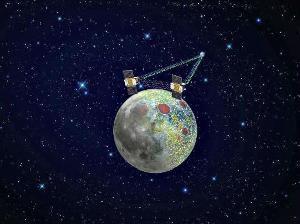May 31, 2013
NEW DELHI: The asteroid that is going to zip past the Earth at nearly 6 million kilometers away tonight is not travelling alone. NASA scientists tracking the asteroid with the giant Deep Space Network antenna in California have discovered that the asteroid has a small satellite or moon.

May 31, 2013
NEW DELHI: The asteroid that is going to zip past the Earth at nearly 6 million kilometers away tonight is not travelling alone. NASA scientists tracking the asteroid with the giant Deep Space Network antenna in California have discovered that the asteroid has a small satellite or moon.

NASA's Gravity Recovery and Interior Laboratory (GRAIL) mission has uncovered the origin of massive invisible regions that make the moon's gravity uneven, a phenomenon that affects the operations of lunar-orbiting spacecraft.
The asteroid is about 2.7 kilometers in diameter. The newly found moon that orbits it is just 600 meters wide. Such a 'binary' or double system is rare but not unknown to space watchers. About 16 per cent of asteroids with diameters 200 meters or more are binary or even triple systems, a NASA statement said.
In astronomical terms, the asteroid has come quite 'close' to Earth, even at 5.8 million kilometers. At this distance, scientists are able to use the radar to track the incoming body. This is especially needed because the asteroid 1998 QE2 is covered with a sooty black substance making it very dim. Radar observations showed a bright 'moon' against the dark surfave of the asteroid. The radar observations were led by scientist Marina Brozovic of Nasa's Jet Propulsion Laboratory, Pasadena, Calif.
The closest approach of the asteroid occurs on May 31 at 1:59pm Pacific (4:59pm Eastern / 20:59 UTC), which is about 4:29 AM Indian Standard Time. This is the closest approach the asteroid will make to Earth for at least the next two centuries. Asteroid 1998 QE2 was discovered on Aug. 19, 1998, by the Massachusetts Institute of Technology Lincoln Near Earth Asteroid Research (LINEAR).
It is called 1998 QE2 because of a naming system adopted by scientists as they discover dozens of cosmic objects like asteroids and comets every year. The first part is the number '1998' which refers to the year of discovery. 'Q' refers to its discovery date which falls in the second half of August. The final part 'E2' refers to the sequence of discovery in the second half of August that year.
In 2016, NASA will launch a robotic probe to one of the most potentially hazardous of the known 'near-Earth objects'. The OSIRIS-REx mission to asteroid (101955) Bennu will be a pathfinder for future spacecraft designed to perform reconnaissance on any newly-discovered threatening objects. Aside from monitoring potential threats, the study of asteroids and comets enables a valuable opportunity to learn more about the origins of our solar system, the source of water on Earth, and even the origin of organic molecules that lead to the development of life.
NASA recently announced development of a first-ever mission to identify, capture and relocate an asteroid for human exploration. Using game-changing technologies this mission would mark an unprecedented technological achievement that raises the bar of what humans can do in space. Capturing and redirecting an asteroid will integrate the best of NASA's science, technology and human exploration capabilities and draw on the innovation of America's brightest scientists and engineers.
Courtesy: TOI
















































































































